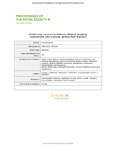A bird’s eye view on turbulence: Seabird foraging associations with evolving surface flow features
| dc.contributor.author | Lieber, L | |
| dc.contributor.author | Langrock, R | |
| dc.contributor.author | Nimmo-Smith, Alex | |
| dc.date.accessioned | 2021-04-12T12:42:35Z | |
| dc.date.issued | 2021-04-28 | |
| dc.identifier.issn | 0962-8452 | |
| dc.identifier.issn | 1471-2954 | |
| dc.identifier.other | rspb.2021.0592 | |
| dc.identifier.uri | http://hdl.handle.net/10026.1/17034 | |
| dc.description.abstract |
<jats:p>Understanding physical mechanisms underlying seabird foraging is fundamental to predict responses to coastal change. For instance, turbulence in the water arising from natural or anthropogenic structures can affect foraging opportunities in tidal seas. Yet, identifying ecologically important localized turbulence features (e.g. upwellings approximately 10–100 m) is limited by observational scale, and this knowledge gap is magnified in volatile predators. Here, using a drone-based approach, we present the tracking of surface-foraging terns (143 trajectories belonging to three tern species) and dynamic turbulent surface flow features in synchrony. We thereby provide the earliest evidence that localized turbulence features can present physical foraging cues. Incorporating evolving vorticity and upwelling features within a hidden Markov model, we show that terns were more likely to actively forage as the strength of the underlying vorticity feature increased, while conspicuous upwellings ahead of the flight path presented a strong physical cue to stay in transit behaviour. This clearly encapsulates the importance of prevalent turbulence features as localized foraging cues. Our quantitative approach therefore offers the opportunity to unlock knowledge gaps in seabird sensory and foraging ecology on hitherto unobtainable scales. Finally, it lays the foundation to predict responses to coastal change to inform sustainable ocean development.</jats:p> | |
| dc.format.extent | 20210592- | |
| dc.format.medium | Print-Electronic | |
| dc.language | en | |
| dc.language.iso | en | |
| dc.publisher | Royal Society, The | |
| dc.subject | foraging cues | |
| dc.subject | seabirds | |
| dc.subject | oceanographic features | |
| dc.subject | turbulence | |
| dc.subject | unmanned aerial vehicles | |
| dc.subject | hidden Markov model | |
| dc.title | A bird’s eye view on turbulence: Seabird foraging associations with evolving surface flow features | |
| dc.type | journal-article | |
| dc.type | Journal Article | |
| dc.type | Research Support, Non-U.S. Gov't | |
| plymouth.author-url | https://www.webofscience.com/api/gateway?GWVersion=2&SrcApp=PARTNER_APP&SrcAuth=LinksAMR&KeyUT=WOS:000645596700012&DestLinkType=FullRecord&DestApp=ALL_WOS&UsrCustomerID=11bb513d99f797142bcfeffcc58ea008 | |
| plymouth.issue | 1949 | |
| plymouth.volume | 288 | |
| plymouth.publication-status | Published | |
| plymouth.journal | Proceedings of the Royal Society B: Biological Sciences | |
| dc.identifier.doi | 10.1098/rspb.2021.0592 | |
| plymouth.organisational-group | /Plymouth | |
| plymouth.organisational-group | /Plymouth/Faculty of Science and Engineering | |
| plymouth.organisational-group | /Plymouth/Faculty of Science and Engineering/School of Biological and Marine Sciences | |
| plymouth.organisational-group | /Plymouth/PRIMaRE Publications | |
| plymouth.organisational-group | /Plymouth/REF 2021 Researchers by UoA | |
| plymouth.organisational-group | /Plymouth/REF 2021 Researchers by UoA/UoA07 Earth Systems and Environmental Sciences | |
| plymouth.organisational-group | /Plymouth/Research Groups | |
| plymouth.organisational-group | /Plymouth/Research Groups/Marine Institute | |
| plymouth.organisational-group | /Plymouth/Users by role | |
| plymouth.organisational-group | /Plymouth/Users by role/Academics | |
| dc.publisher.place | England | |
| dcterms.dateAccepted | 2021-04-01 | |
| dc.rights.embargodate | 2021-5-28 | |
| dc.identifier.eissn | 1471-2954 | |
| dc.rights.embargoperiod | Not known | |
| rioxxterms.versionofrecord | 10.1098/rspb.2021.0592 | |
| rioxxterms.licenseref.uri | http://www.rioxx.net/licenses/all-rights-reserved | |
| rioxxterms.licenseref.startdate | 2021-04-28 | |
| rioxxterms.type | Journal Article/Review |


